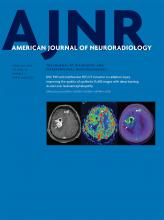Index by author
Tomasian, A.
- InterventionalYou have accessPercutaneous CT-Guided Skull Biopsy: Feasibility, Safety, and Diagnostic YieldA. Tomasian, T.J. Hillen and J.W. JenningsAmerican Journal of Neuroradiology February 2019, 40 (2) 309-312; DOI: https://doi.org/10.3174/ajnr.A5949
Triulzi, F.M.
- Pediatric NeuroimagingYou have accessBrain DSC MR Perfusion in Children: A Clinical Feasibility Study Using Different Technical Standards of Contrast AdministrationS. Gaudino, M. Martucci, A. Botto, E. Ruberto, E. Leone, A. Infante, A. Ramaglia, M. Caldarelli, P. Frassanito, F.M. Triulzi and C. ColosimoAmerican Journal of Neuroradiology February 2019, 40 (2) 359-365; DOI: https://doi.org/10.3174/ajnr.A5954
Tsang, A.C.O.
- Spine Imaging and Spine Image-Guided InterventionsYou have accessSingle-Needle Lateral Sacroplasty TechniqueP.J. Nicholson, C.A. Hilditch, W. Brinjikji, A.C.O. Tsang and R. SmithAmerican Journal of Neuroradiology February 2019, 40 (2) 382-385; DOI: https://doi.org/10.3174/ajnr.A5884
Tu, N.
- EDITOR'S CHOICEHead & NeckOpen AccessTreatment Response Prediction of Nasopharyngeal Carcinoma Based on Histogram Analysis of Diffusional Kurtosis ImagingN. Tu, Y. Zhong, X. Wang, F. Xing, L. Chen and G. WuAmerican Journal of Neuroradiology February 2019, 40 (2) 326-333; DOI: https://doi.org/10.3174/ajnr.A5925
Thirty-six patients with an initial diagnosis of locoregionally advanced nasopharyngeal carcinoma and diffusional kurtosis imaging acquisitions before and after neoadjuvant chemotherapy were enrolled. Patients were divided into respond-versus-nonrespond groups after neoadjuvant chemotherapy and residual-versus-nonresidual groups after radiation therapy. Receiver operating characteristic analysis indicated that setting pre-D50th = 0.875 x 10-3 mm2/s as the cutoff value could result in optimal diagnostic performance for neoadjuvant chemotherapy response prediction (area under the curve = 0.814, sensitivity = 0.70, specificity = 0.92), while the post-K90th = 1.035 (area under the curve = 0.829, sensitivity = 0.78, specificity = 0.72) was optimal for radiation therapy response prediction. Histogram analysis of diffusional kurtosis imaging may potentially predict the neoadjuvant chemotherapy and short-term radiation therapy response in locoregionally advanced nasopharyngeal carcinoma.
Tutino, V.M.
- NeurointerventionOpen AccessOstium Ratio and Neck Ratio Could Predict the Outcome of Sidewall Intracranial Aneurysms Treated with Flow DivertersN. Paliwal, V.M. Tutino, H. Shallwani, J.S. Beecher, R.J. Damiano, H.J. Shakir, G.S. Atwal, V.S. Fennell, S.K. Natarajan, E.I. Levy, A.H. Siddiqui, J.M. Davies and H. MengAmerican Journal of Neuroradiology February 2019, 40 (2) 288-294; DOI: https://doi.org/10.3174/ajnr.A5953
Vachha, B.
- FunctionalOpen AccessResting-State Functional Connectivity of the Middle Frontal Gyrus Can Predict Language Lateralization in Patients with Brain TumorsS. Gohel, M.E. Laino, G. Rajeev-Kumar, M. Jenabi, K. Peck, V. Hatzoglou, V. Tabar, A.I. Holodny and B. VachhaAmerican Journal of Neuroradiology February 2019, 40 (2) 319-325; DOI: https://doi.org/10.3174/ajnr.A5932
Verdoorn, J.T.
- Spine Imaging and Spine Image-Guided InterventionsYou have accessRenal Contrast on CT Myelography: Diagnostic Value in Patients with Spontaneous Intracranial HypotensionK.A. Kinsman, J.T. Verdoorn, P.H. Luetmer, M.S. Clark and F.E. DiehnAmerican Journal of Neuroradiology February 2019, 40 (2) 376-381; DOI: https://doi.org/10.3174/ajnr.A5934
Verhulst, F.C.
- Pediatric NeuroimagingOpen AccessCavum Septum Pellucidum in the General Pediatric Population and Its Relation to Surrounding Brain Structure Volumes, Cognitive Function, and Emotional or Behavioral ProblemsM.H.G. Dremmen, R.H. Bouhuis, L.M.E. Blanken, R.L. Muetzel, M.W. Vernooij, H.E. Marroun, V.W.V. Jaddoe, F.C. Verhulst, H. Tiemeier and T. WhiteAmerican Journal of Neuroradiology February 2019, 40 (2) 340-346; DOI: https://doi.org/10.3174/ajnr.A5939
Vernooij, M.W.
- Pediatric NeuroimagingOpen AccessCavum Septum Pellucidum in the General Pediatric Population and Its Relation to Surrounding Brain Structure Volumes, Cognitive Function, and Emotional or Behavioral ProblemsM.H.G. Dremmen, R.H. Bouhuis, L.M.E. Blanken, R.L. Muetzel, M.W. Vernooij, H.E. Marroun, V.W.V. Jaddoe, F.C. Verhulst, H. Tiemeier and T. WhiteAmerican Journal of Neuroradiology February 2019, 40 (2) 340-346; DOI: https://doi.org/10.3174/ajnr.A5939
Wada, A.
- Adult BrainOpen AccessEffect of Gadolinium on the Estimation of Myelin and Brain Tissue Volumes Based on Quantitative Synthetic MRIT. Maekawa, A. Hagiwara, M. Hori, C. Andica, T. Haruyama, M. Kuramochi, M. Nakazawa, S. Koshino, R. Irie, K. Kamagata, A. Wada, O. Abe and S. AokiAmerican Journal of Neuroradiology February 2019, 40 (2) 231-237; DOI: https://doi.org/10.3174/ajnr.A5921
- EDITOR'S CHOICEAdult BrainOpen AccessImproving the Quality of Synthetic FLAIR Images with Deep Learning Using a Conditional Generative Adversarial Network for Pixel-by-Pixel Image TranslationA. Hagiwara, Y. Otsuka, M. Hori, Y. Tachibana, K. Yokoyama, S. Fujita, C. Andica, K. Kamagata, R. Irie, S. Koshino, T. Maekawa, L. Chougar, A. Wada, M.Y. Takemura, N. Hattori and S. AokiAmerican Journal of Neuroradiology February 2019, 40 (2) 224-230; DOI: https://doi.org/10.3174/ajnr.A5927
Forty patients with MS were prospectively included and scanned (3T) to acquire synthetic MR imaging and conventional FLAIR images. Synthetic FLAIR images were created with the SyMRI software. Acquired data were divided into 30 training and 10 test datasets. A conditional generative adversarial network was trained to generate improved FLAIR images from raw synthetic MR imaging data using conventional FLAIR images as targets. The peak signal-to-noise ratio, normalized root mean square error, and the Dice index of MS lesion maps were calculated for synthetic and deep learning FLAIR images against conventional FLAIR images, respectively. Lesion conspicuity and the existence of artifacts were visually assessed. The peak signal-to-noise ratio and normalized root mean square error were significantly higher and lower, respectively, in generated-versus-synthetic FLAIR images in aggregate intracranial tissues and all tissue segments. The Dice index of lesion maps and visual lesion conspicuity were comparable between generated and synthetic FLAIR images. Using deep learning, the authors conclude that they improved the synthetic FLAIR image quality by generating FLAIR images that have contrast closer to that of conventional FLAIR images and fewer granular and swelling artifacts, while preserving the lesion contrast.








